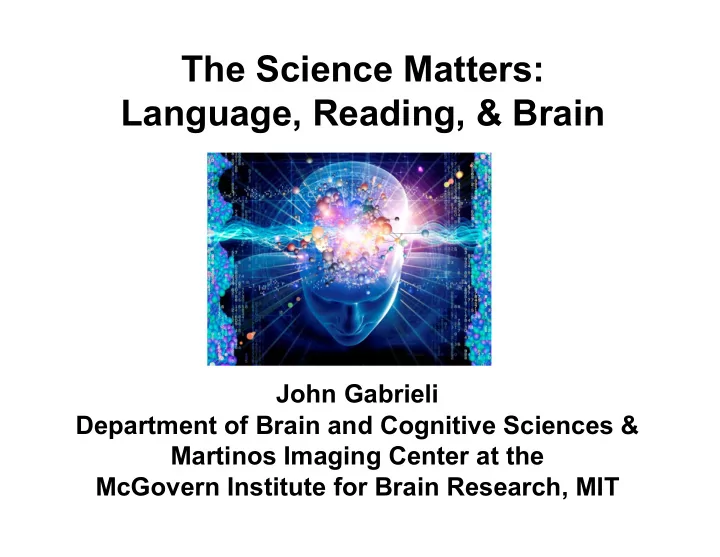

The Science Matters: Language, Reading, & Brain John Gabrieli Department of Brain and Cognitive Sciences & Martinos Imaging Center at the McGovern Institute for Brain Research, MIT
The Science Matters: Language, Reading, & Brain • Home Language & Brain • Supporting Early Reading for At-Risk Children • New Synergy: Reading, Equity, and Education
VARIABLE EARLY EXPOSURE TO LANGUAGE • Hart & Risley (1995) - record each month for 2.5 years one full hour of every word spoken at home between parent and child in 42 families, categorized as professional, working class, or welfare families (SES) - code and analyze every utterance in 1,318 transcripts - 30,000 pages Key findings • variation in children’s IQ and language ability related to amount parents speak to children • children’s academic success at ages 9-10 related to amount of talk heard at ages 0-3
30 Million Word Gap
Early Language Experience Great variability in language exposure within SES groups (LENA Natural Language Study, 2006)
Quantity & Quality of Language Experience • Quantity -- words heard • Quality -- child-directed speech -- conversational turns “serve-and-volley” talking
LENA = Language ENvironment Analysis • Small, child-worn recorder than can hold a whole day’s worth of audio (≥16 hours) • Software automatically analyzes recordings and determines: • How many “adult words” the child heard • How many “child vocalizations” the child said • How many “conversational turns” occurred between the child and any adult
SES “gaps” in Vocabulary & Words Heard n = 60 children ages 4-6 years � �� �� � �� ������� �� �� � �� � ��� �� � ��� �� ���� �� ���� ��� Romeo et al., SfN 2016
Neuroimaging grey matter structure (MRI) grey matter function (fMRI) white matter structure (DTI)
Functional Magnetic Resonance Imaging (fMRI) of Language Comprehension • Forward Speech (stories) comprehensible • Backward Speech incomprehensible, similar perception Forward > Backward Speech - across all children - varies with language experience
Language Areas of the Human Brain
Language Exposure and the Brain z = More Conversational Turns Correlated with Greater Activation in Broca’s area (pars triangularis + pars opercularis � Romeo et al., Cerebral Cortex , 2018
Language Exposure and the Brain z = nonverbal SES cognitive abilities verbal all three abilities statistical controls Romeo et al., Cerebral Cortex 2018
Language Exposure and the Brain two girls; same age; same SES different # of conversational turns 1200/day 600/day z = Romeo et al., Cerebral Cortex 2018
Grey Matter = Cell Bodies White Matter = Myelinated Axons
WHITE MATTER OF THE HUMAN BRAIN Ture, 2000
Diffusion Tensor Imaging (DTI) • visualizes white matter connectivity in the brain • measures movement of water at microstructural level (microns)
Diffusion Tensor Imaging (DTI) – Tractography red = left-right; blue = up-down; green = front-back
Left Arcuate Fasciculus
Language Exposure and the Brain More Conversational Turns & Greater Structural Connectivity in Left Arcuate Fasciculus Romeo et al., Journal of Neuroscience, 2018
Language Exposure and the Brain More Conversational Turns & Greater Structural Connectivity in Left Arcuate Fasciculus Romeo et al., Journal of Neuroscience, 2018
The Science Matters: Language, Reading, & Brain • Home Language & Brain • Supporting Early Reading for At-Risk Children • New Synergy: Reading, Equity, and Education
Interventions Work for Some Children, but not for all Children • • • + • • ………….. average • Improvement 0 • • • - •
Summer Intervention with Seeing Stars (Lindamood-Bell) • 65 1 st and 2 nd graders with reading disability (RD) • 40 - 6 weeks/100 hours small group intervention • 25 - waiting-list controls • diverse socioeconomic status (SES) - parental income, education, occupation • structural brain imaging before and after Romeo et al., Cerebral Cortex, 2018
About Half of Children Responded to Intervention
About Half of Children Responded to Intervention & Most of Those Were Lower SES
MRI – Lateral Views
Cortical Thickness Analysis
Only Effective Intervention Changes Brain Anatomy No Intervention Control Ineffective Intervention Effective Intervention
The Science Matters: Language, Reading, & Brain • Home Language & Brain • Supporting Early Reading for At-Risk Children • New Synergy: Reading, Equity, and Education
START LINE FOR READING
Reading for All Children • Early Reading – Decoding Essential • Supports for Decoding are most effective in young children (K-1 st grade) – not waiting for failure • Supports for Decoding must be intensive, small group, and in addition to other curriculum • Similar support needed for dyslexia and for lesser environmental support
Reading for All Children • identify children at high risk before or early in reading (K-1 st ) • intensive summer support (100 hours) • science evaluation before and after the support – what works and for whom?
Accelerated Summer Program for Early Reading: Science & Education Intervention – Targeted, Science Science Intensive, Personalized Characterization Evaluation
Reading for All Children • identify children at high risk before or early in reading (K-1 st ) • intensive summer support (100 hours) • science evaluation before and after the support – what works and for whom? • summer 2019 partnerships with MA Dept of Elementary and Secondary Education & Cambridge Public Schools
The Science Matters: Language, Reading, & Brain • Home Language & Brain more conversational turns help grow brain structure and function for all SES • Supporting Early Reading for At-Risk Children summer program supports reading in at-risk children, especially from lower SES families • New Synergy: Reading, Equity, and Education partnership between science & public schools for summer programs in 2019 – more partners wanted
Recommend
More recommend